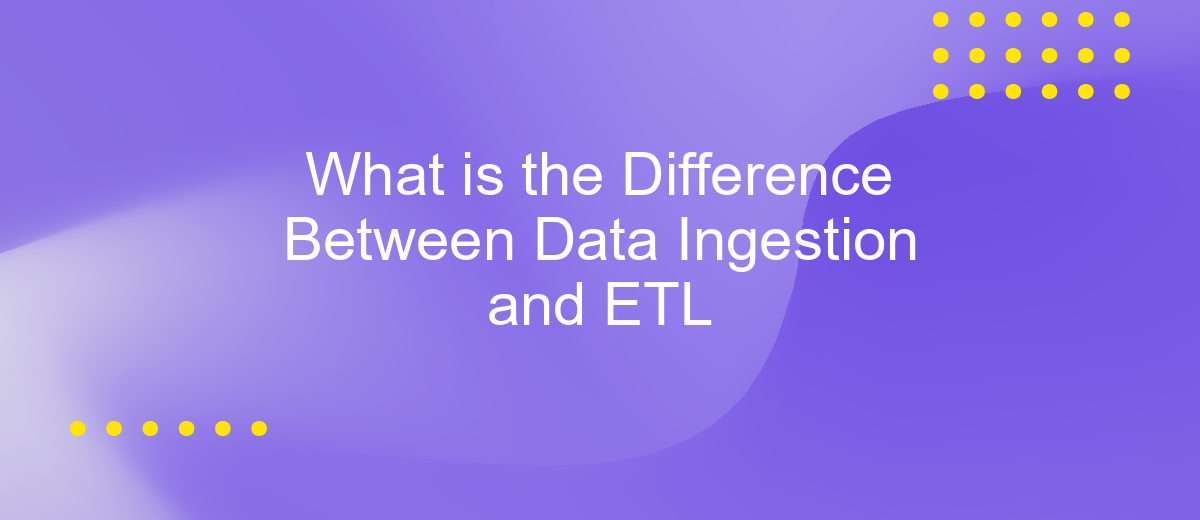What is the Difference Between Data Ingestion and ETL
In the realm of data management, understanding the nuances between data ingestion and ETL (Extract, Transform, Load) is crucial for optimizing data workflows. While both processes are integral to handling large volumes of data, they serve distinct purposes and have unique characteristics. This article delves into the core differences between data ingestion and ETL, helping you navigate their roles in your data strategy.
Data Ingestion and ETL
Data ingestion and ETL (Extract, Transform, Load) are crucial processes in managing and utilizing data effectively. Data ingestion refers to the process of collecting and importing data from various sources into a storage system for further processing. ETL, on the other hand, involves extracting data from these sources, transforming it into a suitable format, and loading it into a destination system, such as a data warehouse.
- Data Ingestion: Focuses on collecting raw data.
- ETL: Involves data extraction, transformation, and loading.
- Purpose: Data ingestion prepares data for ETL processes.
- Tools: Services like ApiX-Drive can automate data ingestion and ETL tasks.
While data ingestion ensures that data from multiple sources is available in a centralized location, ETL processes refine this data for analysis and reporting. Utilizing tools like ApiX-Drive can streamline these operations by automating the integration and transformation of data, making it easier for businesses to gain valuable insights from their data assets.
Key Differences

Data ingestion is the process of collecting and importing data for immediate use or storage in a database. It focuses on the initial phase of data handling, where raw data is gathered from various sources and moved to a destination for further processing. On the other hand, ETL (Extract, Transform, Load) is a more comprehensive process that involves extracting data from different sources, transforming it into a suitable format or structure, and then loading it into a target database or data warehouse. While data ingestion is about the seamless flow of data, ETL emphasizes data transformation and integration.
One key difference lies in the complexity and purpose of each process. Data ingestion is generally simpler and faster, aimed at quickly transferring data without much alteration. ETL, however, is more complex and involves multiple stages to ensure data quality and consistency. For instance, services like ApiX-Drive can streamline data ingestion by automating the collection and transfer of data between applications, but ETL processes often require more sophisticated tools and techniques to handle data transformation and integration. Thus, while both are essential for data management, they serve different roles in the data lifecycle.
Data Warehouse

A Data Warehouse is a centralized repository that stores structured data from multiple sources. It is designed to support business intelligence activities, including querying and analysis. Data Warehouses enable organizations to consolidate data from various operational systems and provide a unified view for decision-making.
- Data Collection: Aggregates data from different sources.
- Data Cleaning: Ensures data quality by eliminating inconsistencies.
- Data Transformation: Converts data into a usable format.
- Data Loading: Transfers the transformed data into the warehouse.
- Data Access: Allows users to query and analyze the data.
Integrating multiple data sources into a Data Warehouse can be complex. Tools like ApiX-Drive can simplify this process by automating data integration. ApiX-Drive connects various applications and services, ensuring seamless data flow into your Data Warehouse. This automation reduces manual effort and enhances data accuracy, making it easier to maintain a comprehensive and reliable data repository for your analytical needs.
ETL Process

The ETL process, which stands for Extract, Transform, Load, is a fundamental procedure in data management. It involves extracting data from various sources, transforming it into a suitable format, and loading it into a target database or data warehouse. This process ensures that data is clean, consistent, and ready for analysis.
The first step, extraction, involves retrieving raw data from different sources such as databases, APIs, and flat files. This data is often unstructured and needs to be processed to be useful. The transformation step then converts this raw data into a structured format, applying rules, functions, and aggregations to make it suitable for the target system.
- Extract: Gather data from multiple sources.
- Transform: Cleanse, format, and structure the data.
- Load: Insert the transformed data into the target system.
Finally, the load step involves loading the transformed data into a target database or data warehouse. Tools like ApiX-Drive can simplify this process by automating data integration tasks, ensuring seamless and efficient data flow between different systems. This enables organizations to make faster and more informed decisions based on accurate data.


ETL Tools
ETL (Extract, Transform, Load) tools are essential for efficiently managing and processing data from various sources. These tools automate the extraction of data from multiple systems, transform it into a suitable format, and load it into a target database or data warehouse. Popular ETL tools like Apache Nifi, Talend, and Microsoft SQL Server Integration Services (SSIS) provide robust solutions for handling complex data workflows, ensuring data consistency, and improving overall data quality. They offer features such as data mapping, cleansing, and real-time processing, which are crucial for businesses to make data-driven decisions.
In addition to traditional ETL tools, there are modern services like ApiX-Drive that simplify the integration process. ApiX-Drive allows users to connect various applications and automate data flows without extensive coding knowledge. This service is particularly useful for small to medium-sized businesses that need to integrate multiple platforms quickly and efficiently. By using ApiX-Drive, organizations can save time and resources, ensuring seamless data integration and enabling more agile business operations. The combination of traditional ETL tools and innovative integration services like ApiX-Drive provides a comprehensive approach to managing data workflows.
FAQ
What is the Difference Between Data Ingestion and ETL?
Can Data Ingestion be part of the ETL process?
What are the main use cases for Data Ingestion?
How can automation tools help in Data Ingestion and ETL processes?
What are the benefits of using an automated tool for Data Ingestion and ETL?
Apix-Drive will help optimize business processes, save you from a lot of routine tasks and unnecessary costs for automation, attracting additional specialists. Try setting up a free test connection with ApiX-Drive and see for yourself. Now you have to think about where to invest the freed time and money!

